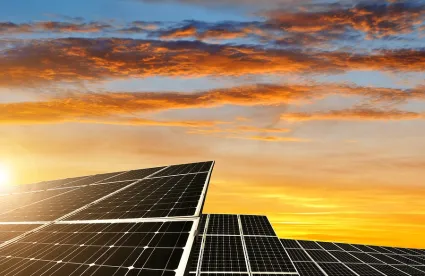Proponents of the development of renewable energy sources have struggled to address the challenge of many renewable energy sources. How do you make electricity when the wind does not blow or the sun does not shine? Many have hoped that innovations in batteries or other large scale power storage systems could provide the answer and perhaps they will, some day. Cynics may say we have been focusing our innovative energies too much on cat videos and “selfies.” However, one solar power project in the Nevada desert midway between Las Vegas and Reno provides a glimmer of hope (and electricity that can power 75,000 homes day and night).
The massive Crescent Dunes Solar Energy Project is a “concentrated solar plant” occupying 1,670 acres of desert that uses 10,000+ mirrors to focus on a receiver containing molten salt that is heated to almost 1,000 degrees Fahrenheit. The receiver is located in the center of the mirror array and stores thermal energy which can be released as needed to heat water into steam which drives generators to make electricity. According to CO.EXIST (a Fast Company online news source focusing on innovations in transportation, energy, education, etc.) Crescent Dunes is the first utility-scale power plant of its kind in the world with built-in storage that cost about $1 billion to build.
The plant which was built by SolarReserve on land owned by the US and managed by the federal Bureau of Land Management provides Las Vegas with 110 megawatts of power throughout the peak period which for Las Vegas is from around noon to midnight. Crescent Dunes’ ability to provide power when it is cloudy as well as after dark distinguishes this concentrated solar plant from the typical photovoltaic solar power plant that can convey energy into the grid but has limited storage capacity.
The Crescent Dunes plant has not avoided controversy. During testing, observers recorded birds being vaporized when they flew into the solar flux. The BLM believes it has fixed the problem by adjusting where the mirrors are pointed but the Basin and Range Watch is suing the BLM to obtain more information and data collected by the biologists.
SolarReserve is working on new projects outside of the U.S. (where subsidies are more readily available) including the Redstone Solar Thermal Power Plant in South Africa and a one-gigawatt $2 billion plant in China that will be 10 times larger than Crescent Dunes.
The largest concentrated solar plant in the U.S., the $2.2 billion Ivanpah Solar Electric Generating System plant in California’s Mojave Desert, also has had trouble with wildlife. This 377 MW plant which relied upon $1.5 billion in federal financing had to manage (temporarily store or relocate) desert tortoises that are on the threatened and endangered species list. After successfully dealing with the tortoises, Ivanpah found that it had killed about 2,000 wild birds between March and August 2015. On March 16, 2016, the Wall Street Journal reported that Ivanpah may be forced to close because it has not been able to successfully adjust its operations to avoid killing birds.
So it appears that concentrated solar plants provide a ray of hope by providing electricity even when the sun is not shining. However, even innovative solar plants located in deserts will need to find a way to avoid killing birds and reptiles to avoid lawsuits if they can otherwise be built and operated economically.



 />i
/>i

